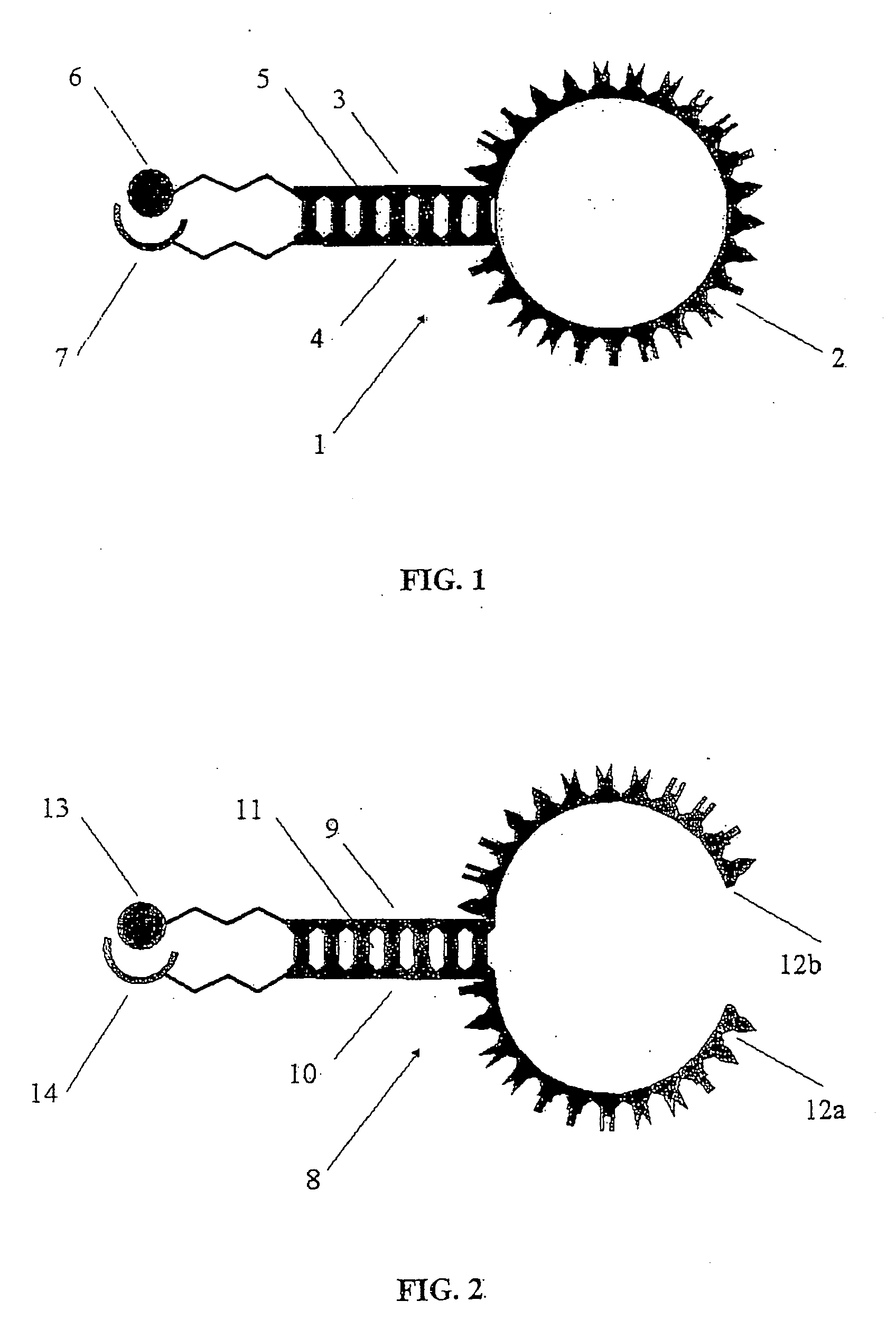Conjugates of photosensitizers and oligonucleotides for selective photochemiotherapy
a technology of oligonucleotide and photosensitizer, which is applied in the direction of therapy, peptide/protein ingredients, genetic material ingredients, etc., can solve the problems of long skin photosensitization, weak absorption in the red wavelength region, and tissue damage and destruction of the irradiated area, etc., and achieve the effect of sufficient tim
- Summary
- Abstract
- Description
- Claims
- Application Information
AI Technical Summary
Benefits of technology
Problems solved by technology
Method used
Image
Examples
example 1
[0125] Example 1 describes the synthesis of two exemplary Ω-sensitizers with two pheophorbide a or chlorin e6 moieties as active pair, respectively. As depicted in FIG. 5 for pheophorbide a the Ω-sensitizer comprises a 20 mer TCS 20, 5′-TGC TAG GTT TCC TCC CTT TC-3′, directed against the epidermal growth factor receptor (EGFR) mRNA. The TCS is directly flanked by two complementary arms 21 and 22 which form the stem duplex in the absence of the target. Two identical photosensitive moieties R are coupled via two different amino carbon spacers 23 and 24 to the 3′ and the 5′ terminus of the arms 21 and 22, respectively. Oligonucleotides were synthesized using an Applied Biosystems 394 DNA synthesizer (Perkin Elmer, Applied Biosystems Inc., Foster City, USA) and standard phosophoramidite chemistry. They were grown on a controlled pore glass support functionalized with an amine group attached via a ten atom linker (5′-DMT-T(C6 Amino)-Suc-CPG Biosearch
TABLE 2Blue RegionGreen RegionRed Re...
example 2
[0128] The selective photosensitizing action of the different Ω-sensitizers described in Example 1 was tested in vitro against sense oligonucleotides, and sense oligonucleotides having one and two base mismatches, respectively. For this purpose oligonucleotides with sequences 5′-CAA AGG GAG GAA ACC TAG CA-3′ (sense), 5′-CAA AGG GAG GTA ACC TAG CA-3′ (sense 1 bp mismatch), and 5′-CAA AGG GAA GTA ACC TAG CA-3′ (sense 2 bp mismatch) were synthesized using standard automated phosphoramidite chemistry. Oligonucleotides were dissolved in 2 ml of a solution containing 10 mM Tris-HCl and 2 mM MgCl2 to give a final concentration of 0.8 μM in a quartz cuvette. To this solution 1 ml Dihydrorhodamine 123 (DHR123) (Molecular Probes, Eugene, USA) (40 μM) dissolved in 10 mM Tris-HCl was added. DHR123 is a non-fluorescent molecule that in the presence of oxygenating species undergoes oxygenation to give the fluorescent dye rhodamine 123 having an absorption maximum at 507 nm and a fluorescence maxi...
example 3
[0131] In order to test the possibility of using nano particles as the quenching moiety, oligonucleotides labeled with a photosensitive moiety at the 3′ terminus, where labeled at the 5′ terminus with amino modified gold nanoparticles. The mam gene sequence S′-CGG ATG AAA CTC TGA GCA ATG TCT GCA GTT CTG TGA GCC AAA G-3′ (GeneBank accession No. AF015224) was coupled to the complementary stem sequences CCA AGC and GCT TGG at its 5′ and 3′ termini, respectively. The sequence was constructed using fully automated DNA synthesis as described in Example 1. The 3′ end contained an amino group, while the 5′ end was equipped with a six carbon spacer thiol group protected by a trityl moiety (Glen Research, Sterling, Va.) using standard methods. Following cleavage with 28% ammonium hydroxide, oligonucleotides were washed and purified as described above. The 3′ end photosensitive moiety labeled oligonucleotide was prepared and purified using the NHS ester of pheophorbide a as described in Exampl...
PUM
| Property | Measurement | Unit |
|---|---|---|
| absorption wavelength | aaaaa | aaaaa |
| absorption wavelength | aaaaa | aaaaa |
| diameter | aaaaa | aaaaa |
Abstract
Description
Claims
Application Information
 Login to View More
Login to View More - R&D
- Intellectual Property
- Life Sciences
- Materials
- Tech Scout
- Unparalleled Data Quality
- Higher Quality Content
- 60% Fewer Hallucinations
Browse by: Latest US Patents, China's latest patents, Technical Efficacy Thesaurus, Application Domain, Technology Topic, Popular Technical Reports.
© 2025 PatSnap. All rights reserved.Legal|Privacy policy|Modern Slavery Act Transparency Statement|Sitemap|About US| Contact US: help@patsnap.com



